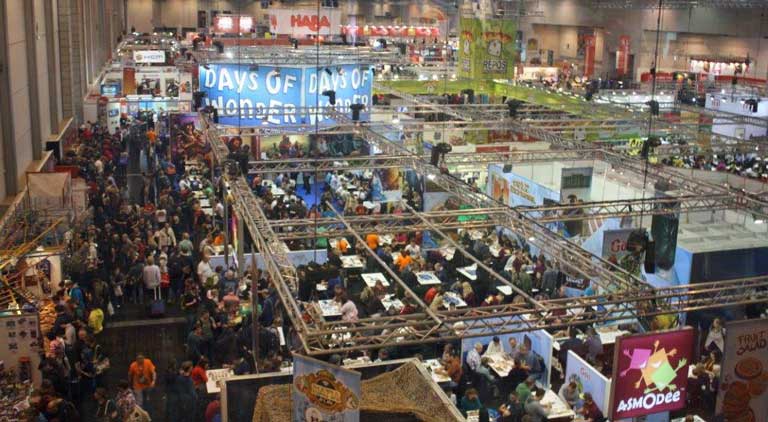A Tale of Three Cars
Pevans reports from Spiel '15 in Essen
This is my report from the 2015 Spiel games fair in Essen, Germany. I started with the games I played at the show, and have expanded it with my experiences of the games I've played since – and links to other reports.
The body of the report is written as a narrative, to be read through from the preamble, but you can also use the links below for the list of exhibitors, list of games and sections of the report.
- List of Exhibitors
- List of Games
- Preamble
- Introduction
- Hall 1
- Hall 2
- Hall 3
- Galeria and Hall 4
- And finally…
It is also available as a PDF document: Spiel '15 report (6 Mb). (You will need Adobe Reader to view this document – use the link to download it if necessary.)
List of exhibitors
This list is all the exhibitors I mention in the report, regardless of how briefly.
List of games
This list is links to my notes on the games I played – or at least had a longer look at – during the show. I have added more since Spiel as I have played them.
Preamble – arriving one day late
I've said before that no games convention is complete without horror stories of the terrible journeys people had getting there. So gather round while I tell 'ee a tale... Those wishing to read about the event itself should skip the next few paragraphs (go direct to the Introduction). This year Mike Dommett was driving and picked me up from home on the Wednesday morning in his nice, two year-old company Mondeo. We made decent time around the M25 and through the tunnel to Calais, turned left and headed for Essen.
It's a four-hour drive from Calais and it always amuses me that most of this is spent in Belgium, the smallest of the four countries we pass through. However, this time we didn't even make it to Belgium. As the border approached, the car decided it didn't fancy it. Mike put his foot on the accelerator, the engine raced and we just slowed down. We pulled off the motorway, parked up in a handy layby and called the AA's European Assistance. (Note that, Mike's mobile being provided by his employer, it doesn't do abroad. Luckily my employer - me - is more enlightened.) Once the AA had worked out where we were, they said someone would be with us in 40-60 minutes.
An hour and a half later, a breakdown truck arrived. The friendly Frenchman driving it agreed we had a problem, but not one he could fix. It would need Ford parts and, it now being five minutes past five, everywhere would be closed. While he winched the car aboard, we consulted the AA, who tried to find us a hire car in which to continue our journey. Forty minutes later (and almost back in Calais), now standing around outside the breakdown guy's garage, we were told they couldn't find anything (everything's closed!). However, they had booked us into a hotel for the night and would sort out a car the following morning.

Waiting to get in to Spiel – but without us! (P)
So Mike and I had an unexpected night in a pleasant hotel on the town square of Gravelines, next to Dunkirk. By ten o'clock Thursday morning (just when Spiel opens its doors) we'd heard nothing, so we chased the AA guys. No luck so far, but they'd keep looking. A couple of hours later they called back to say they'd hired us a car and faxed (!) the details to the hotel. A taxi would pick us up. At 2 pm. Well, it was lunchtime by then.
It took a good half hour to get to the car hire place and a similar amount of time to fill in the paperwork, check over the car and transfer all the luggage (hey, we were in Mike's car, we'd just thrown in anything that might be useful!). Back on the road, at 3:30 pm we passed the junction where we had pulled off exactly 24 hours earlier. Which is why we arrived in Essen at 7:20 pm on the Thursday, neatly missing the first day of Spiel. Aagh!
Spiel '15 – introduction
Those who've been will know that Spiel is a showcase for new games - hundreds of them - as publishers promote their latest for the Christmas season (games are a very seasonal business). The official figures give 910 exhibitors from 41 countries with over 1,000 new releases occupying 63,000 square metres of exhibition hall. The emphasis is on board games, but there's a significant section of role-playing games (most obviously all the live action costumes, weapons and equipment) along with trading/collectible card games, computer games, wargames and everything else. There is also a comics convention, Comic Action, run alongside Spiel. This year there were 162,000 visitors over the four days, with the doors opened early each day because of the crush.
As I point out every year, there is so much to see at Spiel that it's impossible to get round everything. This year I was only there for three days rather than four, so I've seen even less than usual! Hence, as always, the first iteration of my report concentrated on the games I saw and played at the show (and in the evenings afterwards) - what makes Spiel different is that it emphasises playing the games, not just buying them. As I have played more of the games I have added more and will continue to do so. Note that when I refer to a game being like another, I am not suggesting it's a copy. This is just a shorthand way of describing a game by reference to another.
Starting in Hall 3
At the top of the ramp leading up from the U-bahn station outside the Messe (exhibition centre) you have a choice. Veer right to enter through the bustling foyer outside hall 1 with its restaurant and cloakrooms. Or veer left to enter through the light, airy foyer of hall 3. I usually go left, not least because this is also the way to the press centre. Hall 3 is also the largest of the halls and has some of the biggest publishers right at the front.
The big stand that's right in your face as you enter Hall 3 is publisher and distributor Asmodée and features a lot of the smaller publishers (mainly French) whose games they distribute. The big thing here was Space Cowboys' latest, T.I.M.E. Stories, with a separate, sealed area for people to try the game. As the name suggests, this is a game about time travel, with the players as a team of agents travelling back in time to achieve some goal.
The players have limited time and can expect to run out of this the first time they try to complete a mission. Now with a better idea of what they're facing, they get another go. And so on until they succeed (not unlike Tragedy Looper, though it's very much a deduction game). It sounds like designer Manuel Rozoy has come up with a fascinating idea and I expect it's a game that provides terrific stories whether you win or lose. What I don't know is whether there's much replay value once players have 'solved' a scenario. The base game contains one scenario and was launched with a second (The Marcy Case). This is a game I'm really looking forward to trying. Check it out at Space Cowboys.
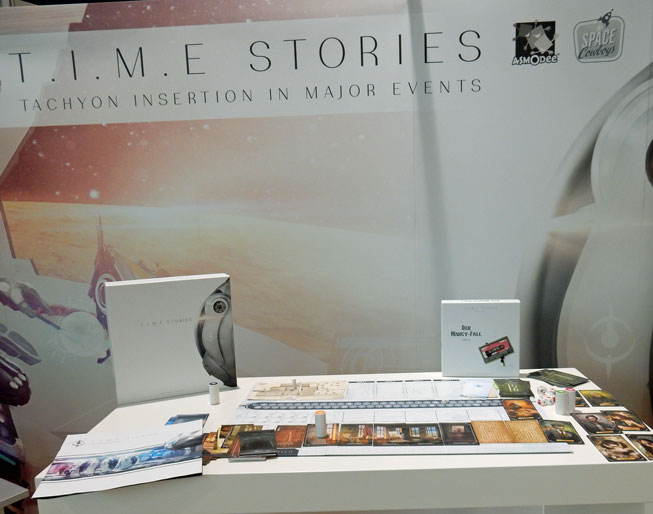
Not much to see, but at least we know what T.I.M.E stands for (P)
Alongside Asmodée was the Kosmos stand with a plethora of new stuff, including expansions for Catan (as we must now call Settlers of Catan - after years of calling it Settlers...). Rudiger Dorn's Steam Time had interesting steam punk artwork, but the actual game looked very abstract. Tumult Royale (from Klaus Teuber and Benjamin Teuber) looked more interesting as each player has their own castle (board). However, it looked pretty abstract as well.
In the next block of stands were a couple of Asmodée associates, Days of Wonder and Repos Production. The only new things I noticed with Days of Wonder were expansions for Five Tribes and Ticket to Ride. Repos were majoring on their expansion for Cash'n Guns, cunningly titled More Cash'n More Guns. It's pretty much what it says on the box. I assumed that 7 Wonders: Duel was a new expansion for 7 Wonders and didn't look more closely. In fact, it's a new two-player version of the game, which sounds more interesting. I shall be intrigued to see if co-designers Antoine Bauza (the man behind the original) and Bruno Cathala have captured the feel (and fun) of the earlier game.
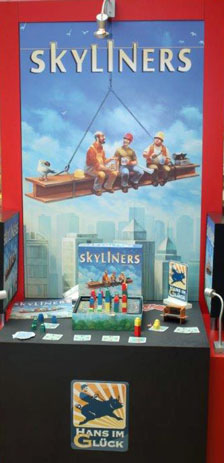
Did I mention vertigo?
The Skyliners display (M)
My first stop of the day was in the same row of stands at veteran publisher Hans im Glück. Here I found several expansions for and new versions of their games (Star Wars Carcassonne anyone?). The new game on display, though, was Skyliners, with its vertigo-inducing cover of a bunch of hard-hatted workers perched on a girder high above a city of skyscrapers (Z-Man Games are producing the English language edition). This was noticeable because it is played in the game's box with players stacking plastic pieces on a squared grid to build skyscrapers.
However, this is not about building as high as you can. Instead, players score points for the buildings they can see in each row from their side of the board. Buildings are obscured if a taller building is closer to the player. Thus, the ideal is to have a line of buildings of increasing height running away from you. On top of this, players get bonuses for placing antennae on top of buildings and for having the tallest building in each section of the board (so there is some incentive to keep building up).
At first sight, Skyliners doesn't seem to be a particularly deep game, but there are definitely some tactical challenges for players. It certainly looks impressive as skyscrapers rise up in variegated colours, interspersed with green parks (which are low points and can't be built on).
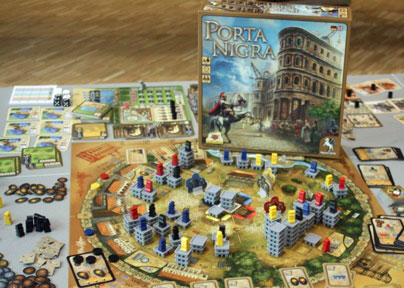
Looks like a city: Porta Nigra on display (M)
Next door to Hans im Glück was eggertspiele and I spotted three new games here. I have to say that I assumed My Village was an expansion for Village, given it was from the same designers (Inka and Markus Brand) and had the same artwork. My mistake: this is a stand-alone dice game, developed from and keeping some of the ideas of Village. As I wasn't a fan of the original, it may be a while before I get around to playing this one. More interesting was Porta Nigra, from the well-respected design duo of (Wolfgang) Kramer and (Michael) Kiesling. This is a card-driven game of Roman city-building, named for the 'black gate' that still stands in the present day German city of Trier. The English edition is published by Stronghold Games and this is definitely one to try.
The eggertspiele game that I have played is Mombasa, produced in English by R&R Games. This is a thoroughly complicated game with pieces to place on the board, tracks on each player's own board and on each company's board, and a deck of cards to manage. I was exhausted just reading the rules. However, the goal of the game is simple enough: have the most money at the end of seven rounds. Though money also includes the value of players' shares in the four chartered companies, which is related to the companies' expansion into Africa. So players are looking to gain more shares and to increase the value of the companies they have shares in.
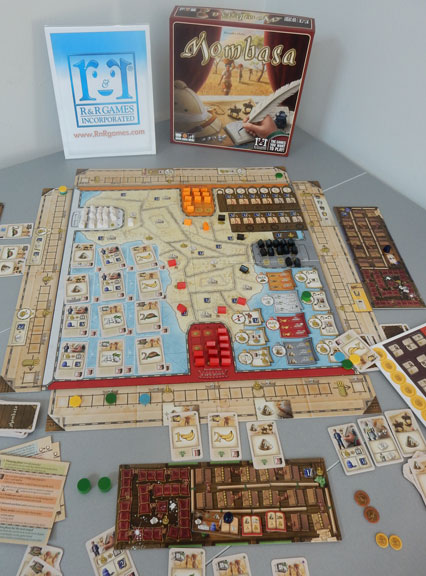
Lots of things going on in Mombasa on R&R’s display (P)
Actions in the game are driven by the cards you play at the start of each round (and one useful objective along the way is increasing the number of cards you can play). There is a clever system for re-cycling your cards - not unlike the mechanism in Historia - that means you're planning not just which cards to play this round, but also which ones you'll have available next round. Actions let you buy cards and shares, expand a company or progress along one of the tracks on your own board. These last provide bonuses during the game and/or points at the end.
On top of this, each player has a couple of 'bonus' markers that enable other actions - at a cost - and can be used each round. Phew! What all this complexity gets you is a lot of choices to make, almost certainly several strategies to try and the need to play the game a couple of times before you know what you're doing. Having got the first of these under my belt, I give Mombasa a provisional 8/10 on my highly subjective scale.
Also on this row was Feuerland Spiele, at their customary long stand along the left-hand wall (as I headed into the hall). The main thing I noticed there was called Alte Dunkle Dinge and looked very familiar in its dark green colour scheme. It turns out this is a German version of Ancient Terrible Things, which I saw last year with the original publisher, Pleasant Company Games from South Africa.
One table on the stand had the prototype of Uwe Rosenberg's next game, which has the working title of Ein Fest für Odin (A Feast for Odin). From what I could make out, this will be the next game in the Agricola-Le Havre-Ora & Labora-Glass Road mould. Players start with a Viking settlement and some workers, deploy their workers to gain stuff and add islands to expand their settlement. At first glance it looks pretty complicated and I didn't manage to get a full explanation. Definitely one to watch out for - next year: see Feuerland Spiele to find out more.
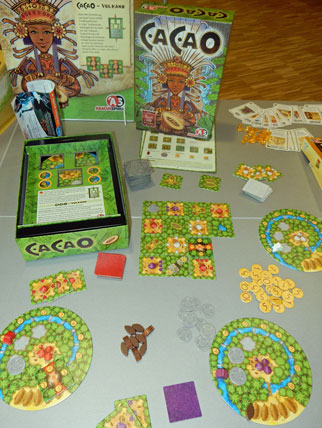
Cacao on display (P)
On the next aisle were my old friends at Abacussspiele. Their new edition of classic card game Tichu looked impressive, but the game I looked at was Cacao, designed by Phil Walker-Harding (a new name to me) and published in the US by Z-Man. I was quite taken with the circular boards that each player has. This represents their home village. However, most of the action is laying square tiles to build up a central jungle area in what is a highly tactical game.
Players have a hand of tiles which show workers on their edge. They add one of these to the tiles in the centre, but not adjacent to any other worker tiles. This may then require them to fill in the spaces with jungle tiles from the central display. In turn, this means workers next to the new tiles carry out the action shown - harvesting cacao 'fruits', selling them at a market for 'gold' or even mining some gold directly.
As you'd expect, the player with the most gold at the end (when players have placed all their tiles) wins the game. However, achieving this is not straightforward as you have to make best use of your workers even as the playing area changes around them. It's an interesting little game and I shall certainly look for an opportunity to play it properly.
French publisher Matagot had a big stand on this aisle. I spotted three new games here. Barony (designed by Marc André) features chunky wooden castles and knights on headache-inducing terrain in a hexagonal grid. The theme is developing and expanding your domain as a medieval Baron - at the expense of your neighbours, of course. Raptor is designed by the Brunos: messrs Cathala and Faidutti. The artwork on the box suggests this is a variation on Jurassic Park. Inside, it's a two-player tactical game pitting the dinosaurs of the title against the human scientists (plus chaos mathematician, big game hunter and assorted children?). It certainly looks interesting, with neat models.
Across the next aisle from Matagot was the yellowness of the Haba stand - their games are always in bright yellow boxes - with lots of child-sized tables and chairs for their customers. They publish some brilliant children's games, but nothing I expect to need a closer look at.
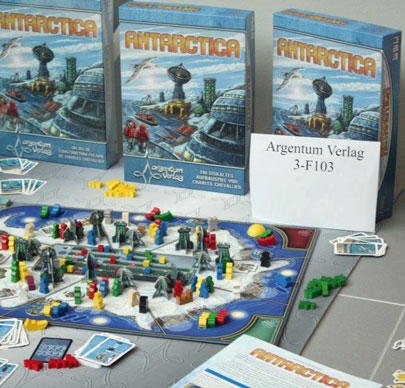
Lots of Antarctica boxes, but just one game (M)
The other side of Haba was German publisher Argentum, one of my regular stopping points at Spiel as they usually have an interesting game to look at. This year the game is Antarctica, designed by Charles Chevallier (and no relation to the children's co-operative game of the same name published by Sunny Games). The game is about research and exploitation on the continent, which is divided into several segments. As the sun moves round, players get the chance to move one of their ships and then take an action, depending on where the ship ends up.
In this way they can build ships, recruit scientists, erect buildings or conduct research in various fields (represented by tracks on the board). This last action can trigger bonuses or extra actions for all players. At the end of the game, players will score points according to how many scientists they have in each area, what buildings they've constructed and what they've researched. In a neat touch, players can discard resources during the game - hampering their progress - to get bonus points at the end.
As well as wooden playing pieces, Antarctica features neat 3D cardboard 'buildings' which make it a visually appealing game, especially as the continent fills up. There are clearly lots of tactical opportunities in the game and I look forward to trying it.
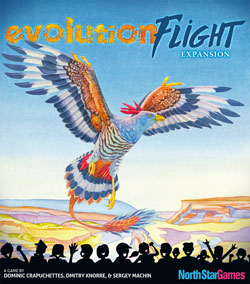 North Star Games's stand was almost buried in copies of Evolution, along with the new expansion for the game, Flight. Evolution is a clever little game that entices players to 'create' carnivorous creatures only
for them to starve to death as the herbivores develop defensive mechanisms (or is this just what happens to me?). As the title
suggests, the Flight expansion adds avian species to the mix. When creating a new species, players can opt to make them avian. This gives certain benefits - they can fly away from terrestrial predators! However, they are limited in size and need extra food each round (flapping those wings takes energy). This is a great expansion for the game and I now incorporate it as standard.
North Star Games's stand was almost buried in copies of Evolution, along with the new expansion for the game, Flight. Evolution is a clever little game that entices players to 'create' carnivorous creatures only
for them to starve to death as the herbivores develop defensive mechanisms (or is this just what happens to me?). As the title
suggests, the Flight expansion adds avian species to the mix. When creating a new species, players can opt to make them avian. This gives certain benefits - they can fly away from terrestrial predators! However, they are limited in size and need extra food each round (flapping those wings takes energy). This is a great expansion for the game and I now incorporate it as standard.
By the way, the second edition of Evolution has a slightly different deck of cards. Some traits have been tweaked and the "Unstable DNA" card removed (something I tend to do with my first edition anyway). North Star have made the second edition deck available on its own for those who want to replace their first edition cards or just need new cards. If you have a first edition game, I recommend picking up the new deck and replacing the original one.
Finnish publisher Lautapelit gets kudos from me for having a new edition of Reiner Knizia's classic Modern Art. Their new games were M.U.L.E. and Perfect Alibi, but I didn't find out anything about either of them. There's also an expansion for Eclipse: Shadow of the Rift.
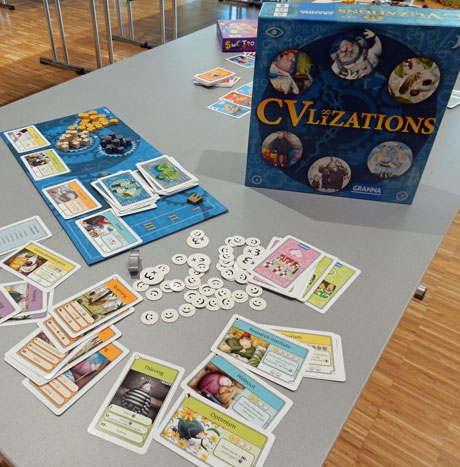
Promotional display of CVlizations (P)
At the end of the next row, Polish publisher Granna is another positioned against the lefthand wall. This year they had CVlizations to show us. Designed by Jan Zalewski this is a civilisation-development game in the style of Granna's earlier CV. In this game, it's the civilisation with the most happiness that wins, which is a nice touch.
The game is essentially a card game, each player having a hand of action cards. Each round, players each choose two of their cards, playing one face-up and the other face-down. All the cards are then revealed and players carry out the actions in numerical order. However, the strength of an action depends on how many players have chosen it. Generally, if only one player chose an action, it's fine. If two chose it, the action is a bit more powerful, but if three or more did, it's less powerful. That's a clever little mechanism. Especially as players all have the same actions in their hands and can't reclaim cards until the end of the 'era', when everybody's played six of their eight cards.
The actions allow players to collect resources, which they can then use to buy ideas cards. Ideas provide bonuses and/or happiness. The game ends after three eras (nine rounds), which isn't long at all, and the player with the most happiness wins. This is a neat and enjoyable little game, enhanced by the endearing artwork. It gets a provisional 9/10 on my highly subjective scale and I hope that Granna are able to find a distributor in the UK soon (their games have now been picked up by Coiledspring).
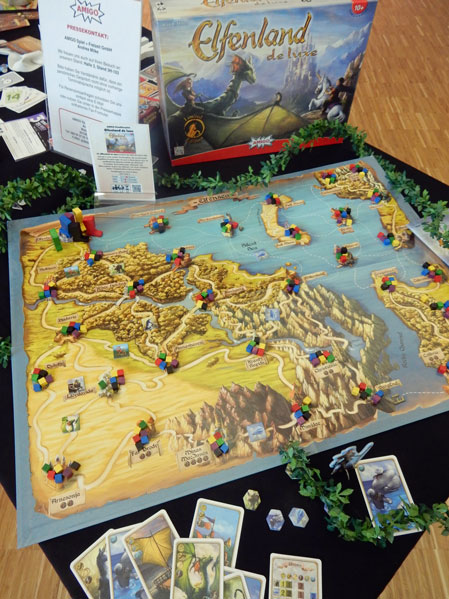
This box says Elfenland de luxe, the English one says Elfenroads (M)
The rest of this row contained some of Germany's games heavyweights. Publisher and distributor Schmidt (they handle Hans im Glück's titles, amongst others) was on one side with Amigo Spiele opposite. Amigo had the usual crop of new games on show. The one that stood out for me was a new "de luxe" edition of Elfenland, renamed to its original title of Elfenroads for the US edition (from Rio Grande Games). This is Alan Moon's classic race game of competing elves using the sort of transport you'd expect from elves: dragons, unicorns, giant pigs... The new edition puts the game back in a large box and incorporates the Elfengold expansion. It also has an alternative map for the new Elfensea version of the game.
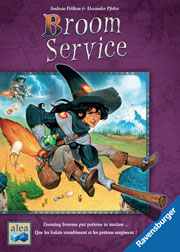 Next along the aisle was German board game giant Ravensburger. As far as I could see Ravensburger's new titles were all children's games. However, alea is their strategy game brand and has published some cracking games over the years. This
year's game is Broom Service, designed by Andreas Pelikan and Alexander Pfister and a development of Andreas Pelikan's earlier Witch's Brew (also published by alea). It's a card game of bluff and risk-taking as players choose roles secretly, trying to out-guess their opponents. They must then decide whether to play safe or take the higher-risk and higher-reward option for that role.
Next along the aisle was German board game giant Ravensburger. As far as I could see Ravensburger's new titles were all children's games. However, alea is their strategy game brand and has published some cracking games over the years. This
year's game is Broom Service, designed by Andreas Pelikan and Alexander Pfister and a development of Andreas Pelikan's earlier Witch's Brew (also published by alea). It's a card game of bluff and risk-taking as players choose roles secretly, trying to out-guess their opponents. They must then decide whether to play safe or take the higher-risk and higher-reward option for that role.
It looks an entertaining game and clearly has something going for it as the Spiel des Jahres jury awarded it this year's Kennerspiel prize. This is for games that are aimed more at gamers than the general, family audience of the main prize. Congratulations to alea for winning the prize, but I have to say that I find it an odd choice.
At the other end of the aisle was Queen Games with a double stand. The new games I saw with Queen were the same that were on show at the 2015 UK Games Expo a few months ago: Parfum and Queen's Architect.
Almost the last of the big stands was Noris Spiele, nowadays the games division of Simba Group. Children's games are the main thing at Noris, too, so I didn't spend much time here.
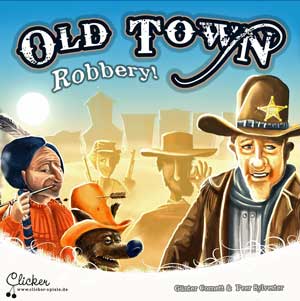 I needed to retrace my steps a bit to fit in the smaller stands I'd missed out. First of these is distributor Spiel Direkt, whose stand had games from several publishers. Here I found a new brain twister from Clicker Spiele. Old Town Robbery,
designed by Günter Cornett and Peer Sylvester, is the latest in the "Old Town" series, set around a Wild West ghost town. It sees a robber exploring the town, looking for opportunities. The players take turns to act as the sheriff, trying to re-trace the robber's steps and identify the buildings he visited. The tricky part is handing the reins from player to player.
I needed to retrace my steps a bit to fit in the smaller stands I'd missed out. First of these is distributor Spiel Direkt, whose stand had games from several publishers. Here I found a new brain twister from Clicker Spiele. Old Town Robbery,
designed by Günter Cornett and Peer Sylvester, is the latest in the "Old Town" series, set around a Wild West ghost town. It sees a robber exploring the town, looking for opportunities. The players take turns to act as the sheriff, trying to re-trace the robber's steps and identify the buildings he visited. The tricky part is handing the reins from player to player.
Along the way, the players construct a story around the robber's activities. This gives them an aid in remembering what the robber was up to. It's billed as a memory and communications game - which seems accurate to me - and is aimed at family play.
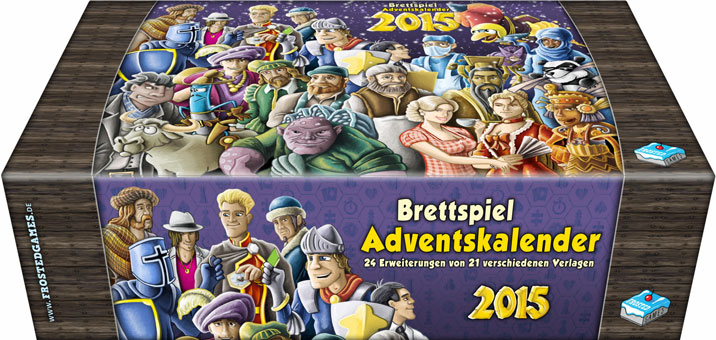
Frosted Games was another small publisher represented on the Spiel Direkt stand. They had a board games Advent calendar for 2015. This is a rather large display box with 24 slots, each containing a mini-expansion (extra counters or cards) for a different game (and all from different publishers). So, each day of December - up to Christmas Eve - you get a little present in the form of an add-on for a game. It's unlikely you'll have all the games, but it's still a brilliant idea. I picked up a copy for myself and had huge fun collecting my expansions through December. It's not a game itself, but it still gets 10/10 on my highly subjective scale.
As well as being main man at Spiel Direkt, Harald Mücke is also behind publisher Mücke Spiele. Hence the new games from Mücke Spiele (amongst others) were to be found on the Spiel Direkt stand: Lignum and Manhattan TraffIQ. Designed by Dirk Arning, Manhattan TraffIQ is an odd game. The idea is simple enough: corner the most lucrative routes around Manhattan for lorries and taxis. However, this is not Manhattan as we know it. Instead, players build their own version by placing tiles. As they do so, they place their taxis and trucks and win if they're the first to get all their vehicles on the board. However, when placing a vehicle, players may also be able to remove some of their opponents' vehicles. It looks an odd mix of deep thought and screwing up the other players - should be fun!
Lignum, designed by Alexander Huemer, is a bigger game, both physically and in complexity. The story is the timber industry in mediaeval Germany with players cutting trees, transporting the timber to their saw mill and selling what they produce. However, the first thing they do each round is move their foreman piece along a track, collecting tools, transport and workers along the way. This is almost a game in itself as players must decide how far to move their foreman each time - the crucial thing is that they can never move backwards.
Having assembled what they need (or what they can get hold of, at least), players then use their resources to gather wood and move it to their processing area, either putting it up for sale immediately or milling it - which needs additional workers and, of course, saws. Milled wood is worth more than raw timber, but not by that much, so there's a close decision here. Wood can also be kept to be sold at a premium in later rounds - at the cost of forgoing income in the meantime.
However, the big money is in completing contracts, which require specific types of wood (did I mention there are three types?) aged for specific times. The game lasts just eight rounds (seasons), two of which are 'winter', when players are severely limited in what they can do - a tactical element is setting up resources to do things in winter, especially the final round. It's a complex game without being anything very special. I enjoyed playing Lignum and give it an initial 7/10 on my highly subjective scale.
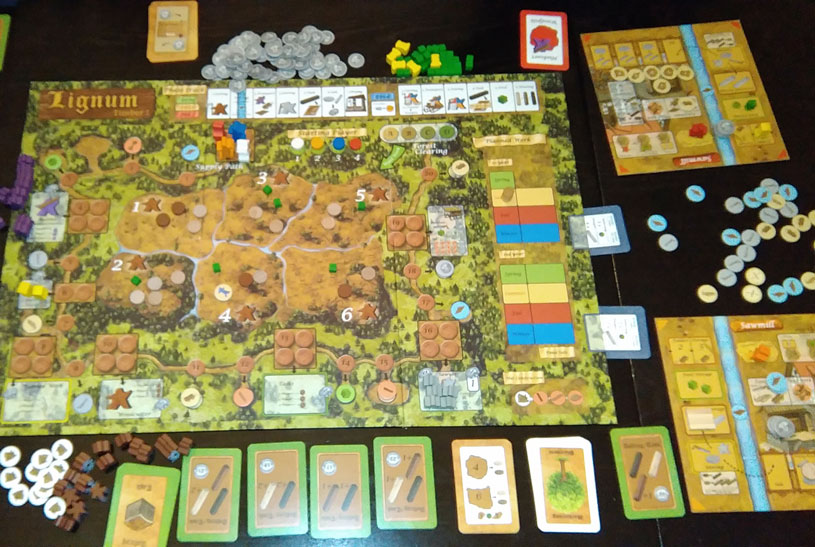
Playing Lignum at the Swiggers games club (P)
A couple of rows back, on row L, I found another of my favourite small publishers, franjos, and had a chat with one of the 'Fran-Jo's, Franz-Josef Herbst. There was a chunky new game on the stand: Domus Domini, designed by Heinz-Georg Thiemann. As this is Latin for "The House of the Lord," I was not surprised to see players with churches in front of them.
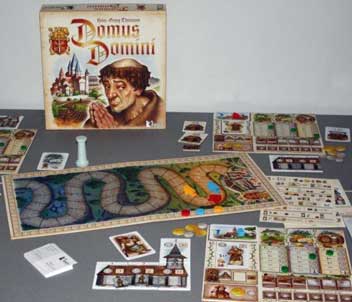
I said there was a church: Domus Domini on display (M)
In fact, each player is running a mediaeval monastery and must donate food to the parent abbey each round. The more you donate, the more victory points you get, but the less cash. Money lets you develop your monastery enabling you to make bigger donations, for greater rewards, in the future. Thus, I anticipate the key decision in the game will be when to switch from bidding low (for cash) to bidding high (for points).
I was immediately taken with the game when I discovered what happens at the start of a round. As the first player is at a slight disadvantage, the player with the marker can pass it to their left by paying a coin. The recipient may do the same. So can the third player and so on until someone decides they really can't afford to carry on! That's a neat little mechanism and I look forward to giving the whole game a go.
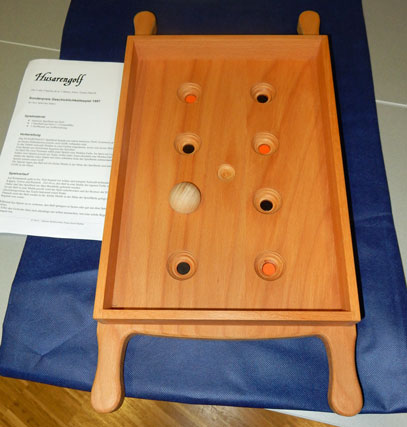
This is Husarengolf (P)
I was even more pleased to see a new version of Husarengolf (designed by Torsten Marold) with franjos. This requires some explanation. It's a physical game played on a deep wooden tray. There are handles at the corners, allowing two players to grip the tray between them. Inside the tray are eight holes, each marked with a colour. A ball goes into the tray and the players have to wrestle with the tray to get the ball into a hole of their colour. While it may sound like this is a game of brute strength, it's much more about dexterity. I can remember howling with laughter when playing the original back in the late Nineties (it won a special Spiel des Jahres award when it was first released in 1997). A definite 9/10 on my highly subjective scale.
You can tell that you're approaching the 2F Spiele stand as the colour green starts to predominate. This year's green box contains the game 504, so called because it is 504 different games. Or variations on a theme, anyway. Remember those children's books in three sections depicting the heads, torsos and legs of different figures? Flip the pages and you get a random, often amusing figure: a Viking warrior wearing a ballerina's tutu, say. Well, designer Friedemann Friese has applied this to board games.
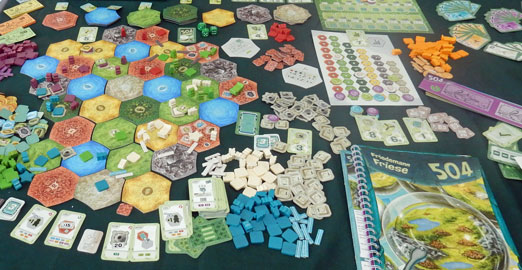
Terrain tiles, loads of bits and the thick rulebook of 504 on display (M)
The rulebook is made up of spiral-bound loose-leaf pages in three sections down the page. Flip the different sections and you get a random set of rules across the visible pages. However, it's a bit more organised than this to make sure you get a viable game: effectively each game is three modules in any order from a set of nine, giving 9 x 8 x 7 = 504 possibilities. This allows both for variations on a theme - 1-2-3 versus 1-2-4 versus 1-2-5, say - and radically different games: 1-2-3 versus 9-8-7.
This is a very clever idea and a lot of work must have gone into it - I had my ear bent about just how much. My problem is that I have enough trouble deciding which game to play without then having to make further decisions about precisely which version. Expansions are bad enough: do we play a 'vanilla' game or add expansion 1 or expansion 2 or both or... Bah! On the other hand, this may be the only game I'll ever need!
Leaving that aside, looking at the game in play, I was immediately struck by its visual resemblance to Settlers as it's played across a 'board' of hexagonal tiles representing different terrain. However, there are a lot more components on top of this - though probably only a few will be needed in any one game. Given the nature of the game, it's difficult to describe how a game will proceed as this depends on just which rules are in play. It may involve conflict, it may involve share-dealing, it may involve producing goods or none of these.
There is a recommended starting game - modules 1-2-3 - which gives a peaceful game of expansion, production and delivery across the full set of land tiles plus bonus cards that give players advantages. I know I'm going to try this game and I will certainly start with this version. The question is how much further I will get with trying the variations...
Despite the name, What's Your Game? is an Italian publisher. They had two new games on their stand, both intricate-looking strategy games. I didn't manage to play either during Spiel, but have had a go at one of them since. Signorie, designed by Andrea Chiarvesio and Pierluca Zizzi, is the one I haven't played. This is a dice game with the players as the heads of noble families in Renaissance Italy.
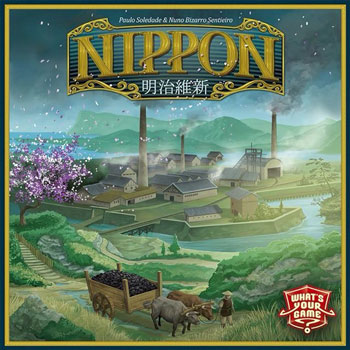 The game I have tried is Nippon, designed by Nuno Bizarro Sentieiro and Paulo Soledade, and set in the Meiji period as Japan industrialises. The players are the Zaibatsu, the major industrial conglomerates that dominated the Japanese economy until after the Second World War. They each have their own board, with several tracks that record income and resources. The main board has a map of the
Japanese islands with spaces in each region for players to place trains and ships and establish influence.
The game I have tried is Nippon, designed by Nuno Bizarro Sentieiro and Paulo Soledade, and set in the Meiji period as Japan industrialises. The players are the Zaibatsu, the major industrial conglomerates that dominated the Japanese economy until after the Second World War. They each have their own board, with several tracks that record income and resources. The main board has a map of the
Japanese islands with spaces in each region for players to place trains and ships and establish influence.
The board also has a table showing the actions available to players. As they take an action, they remove a 'meeple' from the space, placing these onto their own board. Taking the last meeple triggers the end of a round with scoring taking place after a certain number of rounds. The game has a quick finish to ensure it doesn't drag on.
Players only have limited space for meeples on their track and clear them by 'consolidating'. They get their income and a bonus, depending on how many meeples they returned. However, they also have to pay for the meeples (technically, they're foreign consultants, brought in to help Japan develop). The amount to pay goes up with the number of different colours held. This gives players an incentive to take meeples of the same colour, but this constrains their options in which actions to take.
On top of this, players build factories, add equipment, produce goods and fulfil contracts. They add ships and trains as well. Phew! Nippon is a complex game with some neat mechanisms. It gives players a lot of options for what they do and thus some interesting decisions to make. I thoroughly enjoyed my first game and look forward to playing it some more. Nippon gets a provisional 8/10 on my highly subjective scale.
Just round the corner was US publisher Stronghold Games. For me, Stronghold made its name re-publishing some classic, vintage titles, such as Escape from Atlantis. However, it has a strong range of recent games, too, and the company's presence seems to get larger each year. Amongst the new titles this year is their edition of New Dawn (originally from Greek publisher Artipia). Mike, Pete and I took the opportunity to try it out.
New Dawn is a science fiction game of conquest and development with different alien races competing over the real estate. Set in a corner of the galaxy, it has the features you'd expect: developing technologies, establishing bases and attacking the other players. It's played over a square grid to which players must add a 'Facility' each round, gradually expanding the playing area. When they place a Facility card, players get to take the action described on it. One thing to remember is that these actions play no further part, so there's no point taking a facility because it has a useful action on it.
The meat of the game is carrying out actions, notably taking control of an unoccupied Facility (which costs resources) or attacking an occupied one. Bases are placed on the board to show control, but also increase the player's income in the appropriate resource. There are three different resources, so you need to take account of what resources you need and how you're going to get them. The other constraint on actions is where your HQ pieces are. Players only start with one and buying more is a useful way to increase your options - at a cost.
Another action is using one of the available 'Ambassador' cards. As these essentially give an action, often at a discount, they tend to be used first. The game is played over just five rounds with the complexity building up as players add technologies to give them bonuses and extra actions. At the end players score according to the number of facilities they control. They may gain extra points by having built all their bases of a type, acquired lots of technology and built HQs. We thoroughly enjoyed New Dawn, which provides plenty of tactical opportunities. It gets 8/10 on my highly subjective scale.
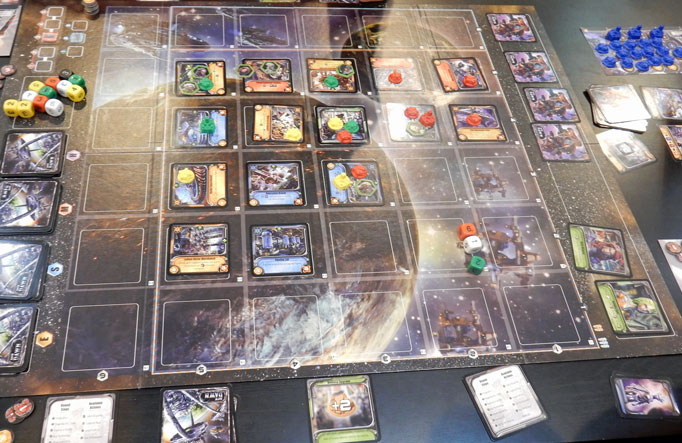
Our game of New Dawn in progress – I’ve only just spotted the background picture on the board (P)
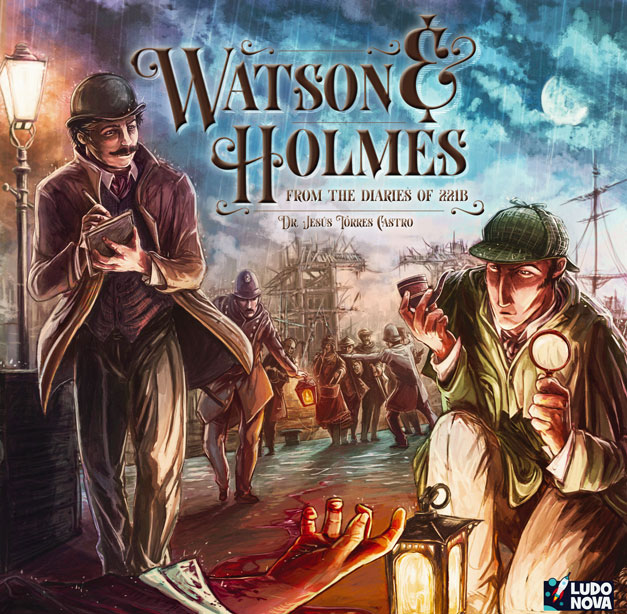 I haven't come across Ludonova (sharing a stand with Numbskull) before, but they have been publishing Spanish-language editions of games for a few years and have now produced their first home-grown game. Watson & Holmes, subtitled "The
221b Diaries", is a deduction game, designed by Jesús Torres Castro.
It comes with a selection of "unpublished cases directly extracted from Doctor John H. Watson's diaries". Each case uses a different layout of location tiles, around which players move to gather clues, spending 'carriages' to do so. As you'd expect, identifying the villain correctly wins you the game, but an incorrect accusation knocks you out. There's nothing particularly new about the game, but it's a nice package. There's more about their games at the website.
I haven't come across Ludonova (sharing a stand with Numbskull) before, but they have been publishing Spanish-language editions of games for a few years and have now produced their first home-grown game. Watson & Holmes, subtitled "The
221b Diaries", is a deduction game, designed by Jesús Torres Castro.
It comes with a selection of "unpublished cases directly extracted from Doctor John H. Watson's diaries". Each case uses a different layout of location tiles, around which players move to gather clues, spending 'carriages' to do so. As you'd expect, identifying the villain correctly wins you the game, but an incorrect accusation knocks you out. There's nothing particularly new about the game, but it's a nice package. There's more about their games at the website.
Aisle N brought me to Indie Boards and Cards with a wide selection of their card games - plus Flash Point. The one new game I spotted was One Night Revolution - kind of a conflation of One Night Werewolf and The Resistance, designed by Ted Alspach. It's a quick playing game of secret identities and deduction. Sounds good.
A bit further along was Iello, one of the French publishers that isn't part of Asmodée. They had what appeared to be a new edition of Stefan Dorra's neat trick-taking card game Nyet! with strange-looking animals illustrating the cards. There was also Sapiens, designed by Cyrille Leroy. It's a game of competing stone age tribes looking for new lands, which involves passing through a dangerous valley. Each player constructs their own valley using tiles. The neat touch is that they have two scores and it's the lower of the two that matters. The graphics are entertaining, too.
At one end of the O row was R&D Games, the imprint of designer Richard Breese. Richard's new game is Inhabit the Earth. This is not at all the cerebral game that I expected. It's more a race to power up your creatures to score points. The game is played over large tiles representing the six continents. Each has a track. When players add a new creature, it starts at the bottom of a track. They can then move it along the track, increasing the points it will score and the cards they can take.
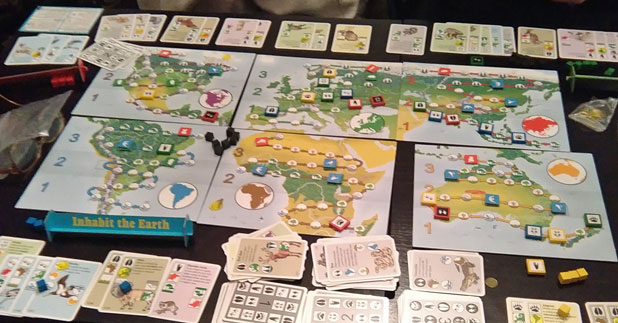
In the middle of a game of Inhabit the Earth (P)
The cards are at the heart of the game. Players use them to move and 'breed' (take more cards). They also use cards to create new creatures and add traits to them, increasing their power and value. The main options facing players are whether to improve and expand their creatures or race along the tracks on the continents. The game finishes when the top of the track has been reached in two of the six continents. This means the speed of the game will vary according to how the players approach it.
It looks like Inhabit the Earth requires a balance of both options with the aim of doing a better job than your opponents. I look forward to exploring the options a lot more over the next months. For the time being it gets 8/10 on my highly subjective scale.
The Fryxelius brothers, who publish as Fryx Games, were just next door, on the P row, with an expansion for their Fleets: the Pleiad Conflict game this year. However, the prototype they were showing off looked fascinating. It's a game about terraforming Mars. I wonder if there's an option to set fire to one of the moons à la Arthur C Clarke's The Sands of Mars? I look forward to the finished article next year.
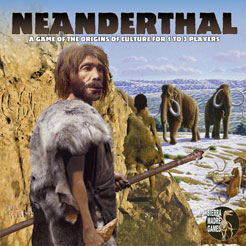 On the stand next to Fryx were designer Phil Eklund and his imprint, Sierra Madre Games. It's clearly been a busy year for Phil, as he had two new games and two new editions on show (and was in the middle of a Kickstarter campaign for a new edition of his
brilliant space exploration game, High Frontier). The first of the new games (in alphabetical order)
is Neanderthal.
Like its predecessor, Greenland, this game is designed for three players and is a struggle for survival.
On the stand next to Fryx were designer Phil Eklund and his imprint, Sierra Madre Games. It's clearly been a busy year for Phil, as he had two new games and two new editions on show (and was in the middle of a Kickstarter campaign for a new edition of his
brilliant space exploration game, High Frontier). The first of the new games (in alphabetical order)
is Neanderthal.
Like its predecessor, Greenland, this game is designed for three players and is a struggle for survival.
The players represent different species of early humans fighting to survive in the Ice Age. They compete for hunting (and gathering) grounds and fight off predators. It's a tough life as the ice spreads, but players can improve their species' chances by developing skills and knowledge and producing lots of children. The key event in the game is transforming into a tribal culture that will enable the species to pass on skills to ensure its continued existence.
Neanderthal uses similar mechanisms to Greenland and can be played as a 'prequel' to that game - players' starting positions in Greenland are then taken from their final positions in Neanderthal. However, the game works perfectly well on its own and I am really looking forward to playing it in earnest (it needs a bit of studying before attempting to play).
The second new game was Pax Pamir. It's sub-titled "Imperial Ambitions in Central Asia" and is set in nineteenth century Afghanistan, "in the shadow of the Pamir Mountains" (so that's where the title comes from). Essentially, it's about Kipling's "Great Game": the political, diplomatic and military intrigues between the British and Russian Empires on the 'North-West Frontier'.
Players are Afghan tribal leaders manoeuvring to be top dog when the music stops. Eventually, the British, the Russians or the Afghans will come out on top and the tribe best aligned to that power will win. The game is thus a combination of improving your own position and jockeying to ensure your preferred empire takes power. Brilliant!
As is pretty obvious, Pax Pamir is a development of Phil's magnificent Pax Porfiriana (where the different factions are lining up for the Mexican revolution). It's credited to Phil Eklund and Cole Wehrle as co-designers, so I assume Mr Wehrle is the man who's brought the period knowledge. As always with Phil's games, the rules and cards are packed with historical detail. It's another game I'm eagerly anticipating.
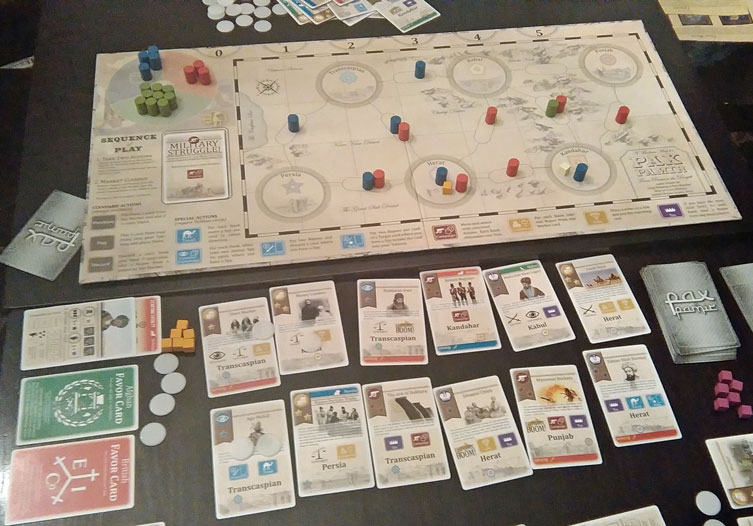
Playing Pax Pamir – with the add-on board (P)
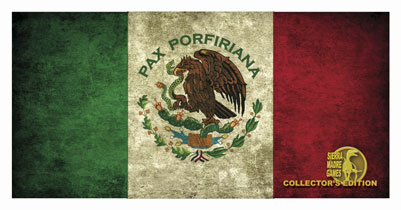 The two new editions were the second edition of Greenland and the "Collector's Edition" of Pax Porfiriana. Greenland hasn't changed much - there are some different components and the latest version of the rules (the "living rules" continue to evolve and are available on the website). The new Pax Porfiriana,
Phil told me, originated as a fan project, beefing up the components and extending the game to six players. It's certainly a bigger package - the original edition barely fitted into its box. As a fan of both games, it's good to see them available again.
The two new editions were the second edition of Greenland and the "Collector's Edition" of Pax Porfiriana. Greenland hasn't changed much - there are some different components and the latest version of the rules (the "living rules" continue to evolve and are available on the website). The new Pax Porfiriana,
Phil told me, originated as a fan project, beefing up the components and extending the game to six players. It's certainly a bigger package - the original edition barely fitted into its box. As a fan of both games, it's good to see them available again.
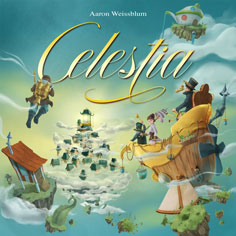 Along the P row was Blackrock Editions, a French publisher with some interesting games to its name. This year they had the fabulously illustrated Celestia. This is a neat push-your-luck game from Aaron
Weissblum. Players are characters in the game's fantasy setting, traveling by balloon. A die roll each turn produces hazards which the balloon can only successfully
avoid if the current captain has the right cards in hand. Players must decide whether to jump out, sharing the treasure found so far, or push their luck by travelling further and hoping to avoid the hazards. Of course, if the balloon comes down, nobody gets anything!
Along the P row was Blackrock Editions, a French publisher with some interesting games to its name. This year they had the fabulously illustrated Celestia. This is a neat push-your-luck game from Aaron
Weissblum. Players are characters in the game's fantasy setting, traveling by balloon. A die roll each turn produces hazards which the balloon can only successfully
avoid if the current captain has the right cards in hand. Players must decide whether to jump out, sharing the treasure found so far, or push their luck by travelling further and hoping to avoid the hazards. Of course, if the balloon comes down, nobody gets anything!
It's a decent little game, but what makes it different is the gorgeous, gorgeous artwork. This lifts the game out of the ordinary and makes it something special. Just for this, Celestia gets 9/10 on my highly subjective scale.
I've not really noticed Flatlined Games in previous years, but was intrigued by this year's game. Steam Rollers is a dice game about the eponymous machinery. However, what attracted me was that players each have a little paper map to draw on, Doodle City style. I do like games that involve destroying the components!
F2Z Entertainment is the umbrella company for the Filosofia and Z-Man brands (among others). Their stand displayed the new games from both of these, many of them French (Filosofia) and English (Z-Man) editions of games on show elsewhere (in German).
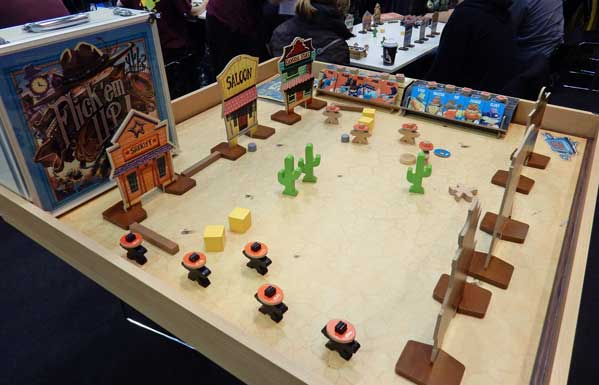
The giant demo version of Flick ’em Up (P)
Alongside the main F2Z stand was Pretzel Games, another F2Z brand, with what may be the silliest game at Spiel. Flick 'em Up! is a Wild West shoot-out where the players take out opposing gunfighter figures by flicking wooden 'bullets' across the table at them. Brilliant! There are rules, but I don't care: a copy came home with me and it gets a provisional 9/10 on my highly subjective scale. Of course, this may well change once I've actually played it...
At the very back corner of Hall 3 several small French publishers had a joint stand. One of these, Ludonaute, had an expansion for last year's terrific Colt Express. Horses and Stagecoach adds, well, take a guess. I assume the expansion will allow players to gallop furiously alongside the train, as happens in all the best Westerns. Discoveries (The Journals of Lewis & Clark) is a dice game by Cédrick Chaboussit in the style of his (and Ludonaute's) 2013 Lewis & Clark. This looked interesting, but I didn't get the chance for a closer look.
Starting in Hall 1
For this part of my report I'm going to start again and veer right on the way up from the U-bahn station. This brings us into the Messe (Exhibition centre) through the South entrance. With a restaurant and large cloakrooms in the foyer, this always feels busier than the West entrance and takes us in to Hall 1, which is kind of a triangular shape. Let's turn left into the short corner, where Treefrog Games, Martin Wallace's imprint, and Surprised Stare Games were sharing a stand.
This is the last time Treefrog Games will be at Spiel in its current form: the company is changing its business model to become a game design studio rather than a publisher. While I understand the rationale behind this, my concern is that we may not see any more heavyweight Martin Wallace games like this year's Ships. It would need a commissioning publisher prepared to give Martin free rein and produce a gamer's game. Fingers crossed.
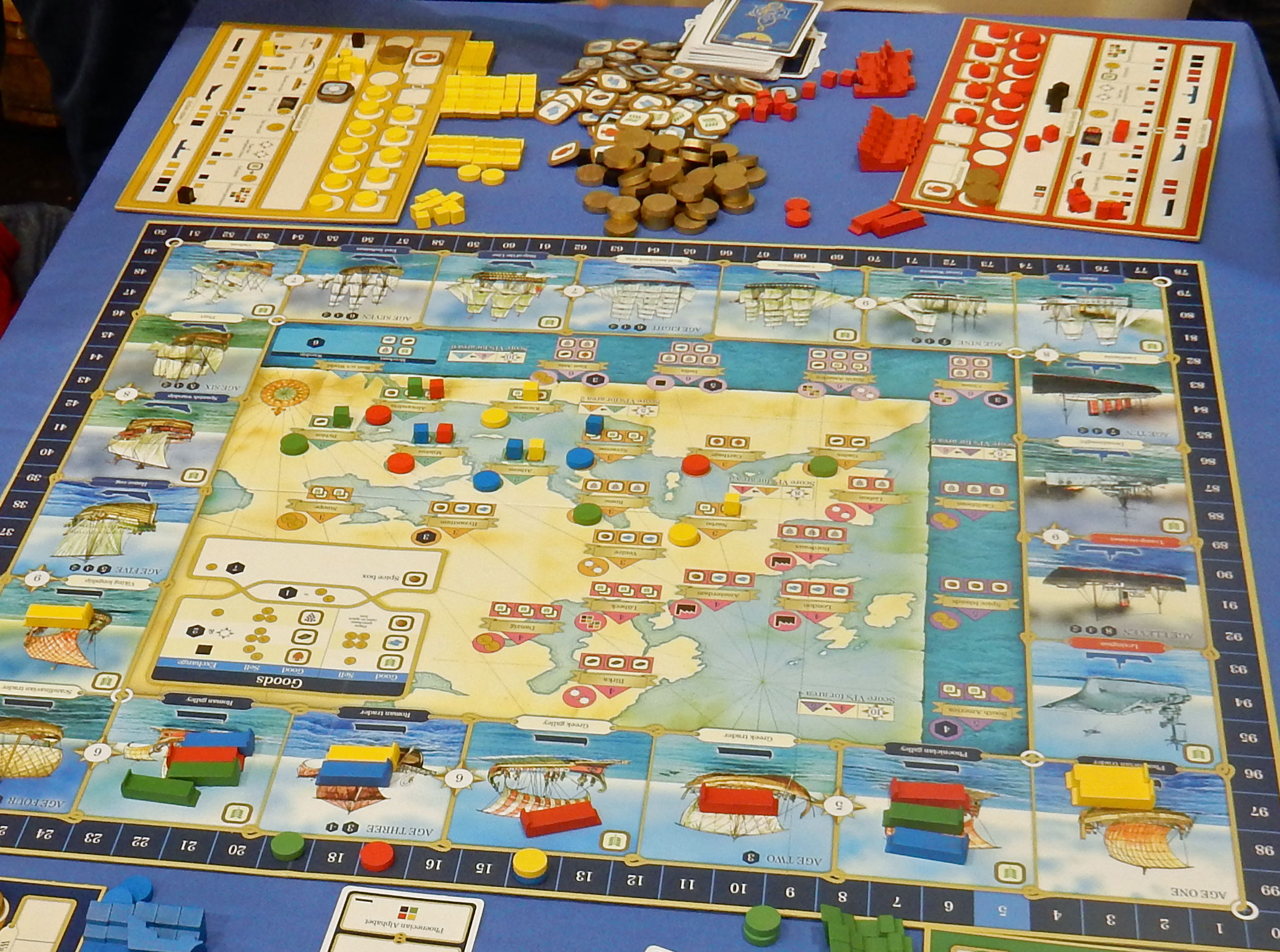
Playing Ships at Swiggers games club (P)
In the meantime, we have Ships, the third in a loose trilogy of transport-related games. In this game, players have ships across three different eras: galleys, sailing ships and steamships. Adding ships to the technology track around the outside of the board allows players to place their merchants and cities on the map in the centre. In turn, this gives them goods, bonus markers and other advantages. However, they can also lose points as technology progresses and older ships become obsolete.
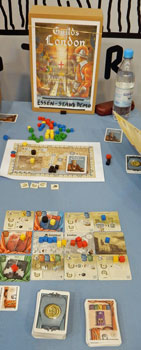
The Guilds of London
prototype (P)
The game requires careful management of players' resources, particularly the cubes that are used both to power players' actions and as merchants on the board. Cubes don't come back until players use an action to retrieve them, so an important decision is when to take that action.
The other important component of the game is the set of cards laid out at the start of each era. These provide different - or cheaper - actions and so tend to be used sooner rather than later. (I've found that hanging on to maximise the benefit of a card means someone else takes it, even if they're not getting very much from it.) As the cards are so useful, players can only use one each turn.
Ships is a complex game that requires players to manage their holdings of several different resources while aiming to maximise the points they score across the whole game. As always, there's a trade-off between taking points early and building up to, hopefully, gain more points later. I've played it twice so far and am struggling to get to grips with it. I give Ships a provisional 9/10 on my highly subjective scale.
As for Surprised Stare, they had some expansions for Snowdonia and the prototype of Guilds of London, which I saw at the UK Games Expo.
Working my way along the aisles, I was taken with one name I came across: Geek Attitude Games. They're a relatively new Belgian publisher, showing their latest game, Taverna, but I didn't have the opportunity to look at this any closer.
In the next aisle I found Dutch publisher Cwali, another of my regular stopping points at Spiel. Designer Corné van Moorsel has a track record of producing some terrific games, whether they melt your brain or run you out of luck. His latest game is Samara, which has an interesting approach to time.
The board holds building tiles arranged in rows and columns. At the start of the rows is a column (marked as "now") that shows the strength (in workers) required to take a tile from each row. Buildings are worth points to players or provide some bonus or special ability. Each shows the tools a player must have to take the building and the tools also start spread out across the spaces of the board. Thus players must first get the tools they need to be able to take the buildings they want - either to make it easier to get more buildings or to score points.
Alongside this board is another pair, divided into a total of twelve columns (each named for a month). Players' worker pawns (meeples, of course) start on the month alongside the "now" column on the main board. When players take a tool or building, they move meeples of the appropriate strength to the column the tile is in, placing them on the appropriate month. Once the "now" column is empty of workers, the month boards slide along to the next month that holds workers. Thus, the further ahead you move workers, the longer it will be before you get them back. Clever or what?
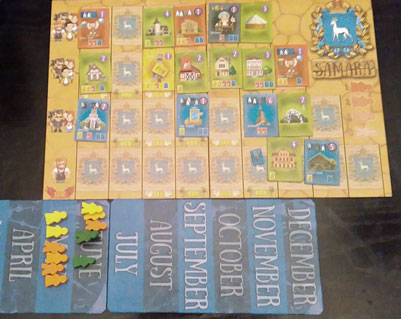
Samara in play at Swiggers games club (P)
Players can, of course, get additional workers (though there are only two more available). This is done by moving a (female!) meeple to the far end of the month track and placing a new piece alongside. Gaining an extra worker may be useful, but it's also expensive, so players will think hard before doing this.
Samara having been a Kickstarter project, there are already two expansions for the game (presumably stretch goals). The first of these adds extra buildings, some of which come with a token to show which meeple has the power given by the building. It also includes secret goals for players that gives them a way of gaining some bonus points. The second expansion has winter and summer boards. One of each is added to the time track, giving periods when work is harder (winter) or easier (summer).
I've played Samara twice since I brought my copy back from Spiel and enjoyed it hugely both times. Corné has designed another excellent game and it gets 9/10 on my highly subjective scale.
Continuing along aisle C, I found dlp Games, who usually have a new game each year. However, this year they just had the "big expansion" for last year's game, Orléans: Invasion. I am sorry to say that Orléans passed me by, so I didn't see much point in looking at the expansion.
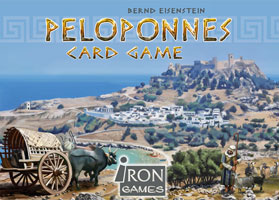 Sharing with dlp was Irongames with Bernd Eisenstein's latest: the Peloponnes Card Game adapts his cracking development game, Peloponnes, into a card game. As the original was a tile-laying game, this isn't too different. However, game
play has been streamlined and it plays quickly. Players build up their ancient Greek city state, adding land (to produce resources) and buildings (using up those resources), which provide victory points and/or advantages.
Sharing with dlp was Irongames with Bernd Eisenstein's latest: the Peloponnes Card Game adapts his cracking development game, Peloponnes, into a card game. As the original was a tile-laying game, this isn't too different. However, game
play has been streamlined and it plays quickly. Players build up their ancient Greek city state, adding land (to produce resources) and buildings (using up those resources), which provide victory points and/or advantages.
Along the way, players will trigger disasters, which they need to prepare for. They can see these coming, though, so have only themselves to blame if they're caught out! A large population is advantageous, but players will need to feed their people at certain points and this is a major constraint through the game. This is a really clever game that plays much more quickly than you think it will. It gets 9/10 on my highly subjective scale and has had several outings at Swiggers games club since my return from Spiel.
As well as coming up with the Peloponnes Card Game, Bernd has produced a 'big box' version of the original Peloponnes that includes all the various expansions (the Goat being my favourite - every game should have room for a Goat).
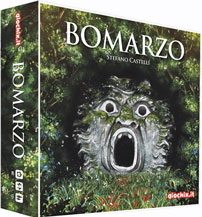 A bit further along was Italian publisher Giochix Editions, another must-visit on my rounds of Spiel. This year main man Michele Quondam was able to show me two new games. Bomarzo, designed by Stefano Castelli, is themed around the park of mythological/monstrous statues commissioned
by sixteenth century Prince Pier Francesco Orsini in the town of Bomarzo. A depiction of the park forms the central board on which the game is played.
A bit further along was Italian publisher Giochix Editions, another must-visit on my rounds of Spiel. This year main man Michele Quondam was able to show me two new games. Bomarzo, designed by Stefano Castelli, is themed around the park of mythological/monstrous statues commissioned
by sixteenth century Prince Pier Francesco Orsini in the town of Bomarzo. A depiction of the park forms the central board on which the game is played.
Players also have their own board, representing the village where they are Lord of the Manor. The village boards show what players produce each round and are where their workers come from. The park's statues are represented by cards, each providing an action that players must pay for. Other cards allow players to develop their village or provide some bonus. The game is full of neat touches: for example, a statue that isn't used in one round becomes 'moss-covered' and is cheaper next round. The game lasts just eight turns, giving players some time pressure. It's another one that I'm looking forward to trying.
Giochix's second game was The Foreign King, designed by Javier Garcia. It's set in the newly created country of Belgium under its first king, Leopold I, a German prince (and Queen Victoria's uncle). A successful Kickstarter project, the game puts players in the roles of Belgian industrialists. They industrialise the provinces of Belgium by building factories, using these to generate income and increase their prestige with the King.

Playing The Foreign King at Swiggers games club (P)
The key mechanism in the game is the action track, which means only one player's pawn can occupy an action at a time. Thus, when it's your turn, the actions available to you are limited to those that are empty, so you must adjust your plans to fit with what you are able to do. I note that there's a special action for a four-player game, allowing a player to take any of the other actions, which should prevent things bogging down. I'm quite taken with this and I look forward to playing it.
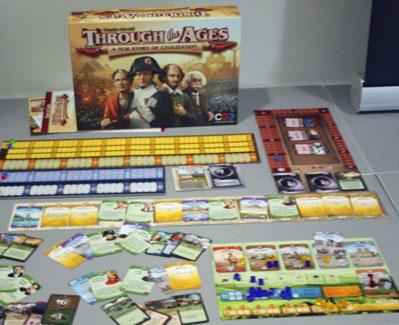
The revised edition of Through the Ages on display at Spiel '15 (M)
Coming back along row D, the big draw for me at Czech Games Editions was the new, revised edition of Through the Ages from Vlaada Chvátil. This looked terrific and it was clear that the game's mechanisms have only been slightly tweaked. Though this has, apparently, streamlined game play - much to the relief of those who call the original "Through the ages and ages..." no doubt. It should arrive in the UK in January, which is not a moment too soon for me.
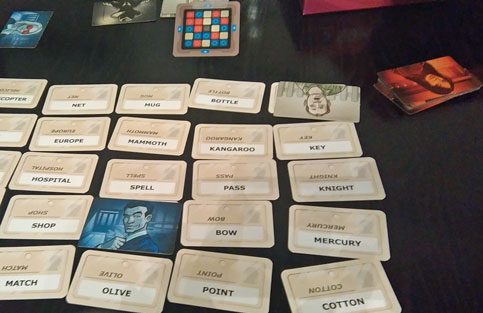
Playing Codenames at Swiggers – one point for blue so far… (P)
However, the main event at CGE was Codenames, Vlaada's latest game. I dismissed this as a parlour game when I first heard of it but should probably be eating my hat about now. The game is played between two teams over a 5 x 5 grid of cards, each with a word printed on it. One member of each team (the codesetter?) says a word that they think connects several of the things named on the cards. They also say how many cards are connected. The rest of the team then has to identify the cards they think are involved.
So far, so parlour game. What makes the game is the display, which only the codesetter can see. This identifies positions on the grid as belonging to one team, the other or neutral. There's also one space that belongs to an assassin. It's not enough for the team to guess the connections, the codesetter must guide them to the items belonging to the right team. Guessing the other team's card gives it to them and guessing the assassin loses the round!
There's one more tactical wrinkle. The guessing team can hold back guesses to use in later rounds. This enables them to hear more code words from their codesetter, giving them more information as to which cards to go for. The result is a surprisingly subtle game that gets 8/10 on my highly subjective scale.
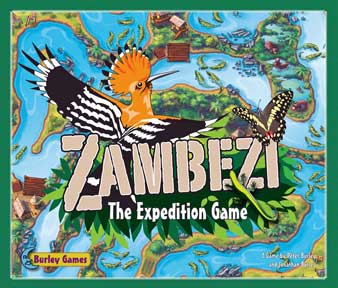 Peter Burley and sons were having a grand time demonstrating and selling Zambezi, the production copies of which arrived in good time for Spiel after a successful Kickstarter campaign. Designed by Peter and Jonathan and published by Burley
Games, this
is a sort-of race game along the eponymous river (though I would spell it Zambesi). I first saw it at
this year's UK Games Expo, so you can find my notes about it in my report of that event.
Peter Burley and sons were having a grand time demonstrating and selling Zambezi, the production copies of which arrived in good time for Spiel after a successful Kickstarter campaign. Designed by Peter and Jonathan and published by Burley
Games, this
is a sort-of race game along the eponymous river (though I would spell it Zambesi). I first saw it at
this year's UK Games Expo, so you can find my notes about it in my report of that event.
There's a certain similarity in look to Greek publisher Artipia's games: they all feature the same very ornate, baroque style of artwork. They have an interesting range of games on quite disparate themes, but I have to say that I didn't notice anything new this year. Find out more at the website (link above).
The smaller Czech outfit, Czech Board Games, had Shuffle Heroes, designed by Jan Vanecek. This looked like two-player card game of duelling wizards. Apart from noticing the dark artwork, I didn't find out any more about it.
At the end of aisle D I spotted that Automania was the new title from Norwegian publisher Aporta Games - the guys who gave us Doodle City last year. As I have fond memories of Ian Livingstone's 1991 Automania, I had to take a look at this one. The only similarity I could see is that they're both about the car-making industry. The games have a very different focus. Aporta's concentrates on running a factory, organising your assembly lines to produce cars that will sell for the best profit. An interesting game that I look forward to playing.
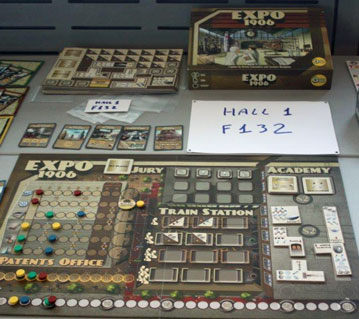
Expo 1906 on display at Spiel '15 (M)
This brought me to the last aisle in the hall. Despite their name and the Italian names of the guys in charge, Gotha Games is a British publisher. I liked the motor racing game (Race! Formula 90) they published a couple of years ago and they had an expansion for this at Spiel. They also had a new game: Expo 1906, designed by Remo Conzadori and Nestore Mangone. This is a neat game of building inventions, represented by pentomino (I think) shapes. These must be fitted together, so there's a Tetris element to the game. The resources required must be next to the invention, so players need to plan what they're going to build where. Players can also develop technologies to make inventions cheaper or publish patents to get extra points from their inventions. It was interesting enough that I picked up a copy and expect to play it soon.
Next was Mayfair's big stand with lots of new games. In pride of place was Extra, Extra, which has now arrived. It's an interesting-looking game of newspaper publishing which, for me, has immediate resonances with the version of Waddington's Scoop! I remember from the 1960s. I found the box art of King Chocolate (designed by Stefan Alexander) amusing as it looks like an up-market bar of chocolate. However, the game itself looks very abstract with a slew of hexagonal tiles in shades of brown. Mystery! (designed by Bruce Glassco) has a murder/mystery theme as players work out suspects' motives and inter-relationships to identify the murderer. It looks intriguing with an interesting off-key feel to the artwork.
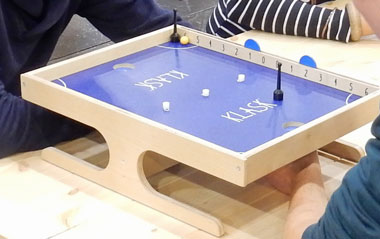
Klask being played at Spiel '15
I have to mention Klask, which was just across the aisle from Mayfair. This is a dexterity game (designed by Mikkel Bertelsen) played on a wooden board on legs. There's a goal at each end – a hole in the middle of the board. The object is to score goals with the ball, which you manipulate with tall pawns controlled from below using a magnet on a wire handle. Bonkers! But clearly enjoyed by everybody who was giving it a go. See more at klask.me.
Then there was G3 with two new games that I could see: Take a Train and Stinky Business. I didn't get to look any closer.
Backspindle Games were demonstrating Clacks, designed by Leonard Boyd and David Brashaw. This is the latest in their series of Discworld games and was also on show at the UK Games Expo a few months earlier. See my Expo report (TWJO 156 and on my website) for a marginally longer description.
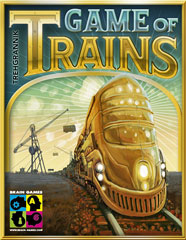 I've been intrigued by the previous games from Brain Games and their latest is a cracker. Designed by Alexey Konnov, Alexey Paltsev and Anatoliy Shklyaro, Game of Trains is a neat little card game. It's simply a set of cards showing railway wagons (with
some amusing illustrations) numbered from 1 to 64 and with icons showing a particular action. There's also a locomotive card for each player, simply to show which end of their row of cards is which.
I've been intrigued by the previous games from Brain Games and their latest is a cracker. Designed by Alexey Konnov, Alexey Paltsev and Anatoliy Shklyaro, Game of Trains is a neat little card game. It's simply a set of cards showing railway wagons (with
some amusing illustrations) numbered from 1 to 64 and with icons showing a particular action. There's also a locomotive card for each player, simply to show which end of their row of cards is which.
Players start with seven cards dealt at random and then arranged in order from high to low. The winner is the first to end up with a row that's in order from low to high. To do this, they either draw a card from the deck and replace one in their row, discarding the replaced card to the centre of the table, or they use the action on one of the cards in the centre and discard it. Simplicity itself, eh?
It's the actions that make the game. Some of them are simple: move one wagon two places to the left, for example. Others force all other players to discard their first (or last, or centre) card and replace it with one drawn at random. Hence players must keep a careful eye on what actions are available and how the other players might mess up their almost-complete set.
 To give you an idea of how much fun this game is, Mike, Pete and I - and a stray German who'd joined us - played it on the Brain Games stand. And immediately played it again. Three of the four promptly bought a copy and at least one of us went back to buy more copies the following day - by which time the three of us had played it twice more. It is a simple game, but it's also
great fun and plays really quickly. Game of Trains was my favourite of the games I played while I was in Essen and gets
a provisional 10/10 on my highly subjective scale.
To give you an idea of how much fun this game is, Mike, Pete and I - and a stray German who'd joined us - played it on the Brain Games stand. And immediately played it again. Three of the four promptly bought a copy and at least one of us went back to buy more copies the following day - by which time the three of us had played it twice more. It is a simple game, but it's also
great fun and plays really quickly. Game of Trains was my favourite of the games I played while I was in Essen and gets
a provisional 10/10 on my highly subjective scale.
The Bézier Games stand can be seen from some distance. No, that's not because of how tall main man Ted Alspach is. It's the green banner suspended from the ceiling above the stand that is so noticeable. Here there were two new games and two expansions. Favor of the Pharaoh is Tom Lehmann's re-working of his 2006 To Court the King and is a dice fest. The original game was about throwing handfuls of dice to make sets, Yahtzee-style, which you used to gain cards that made it easier to make bigger sets to get the cards that scored points. I was not a fan and let the new game pass me by.
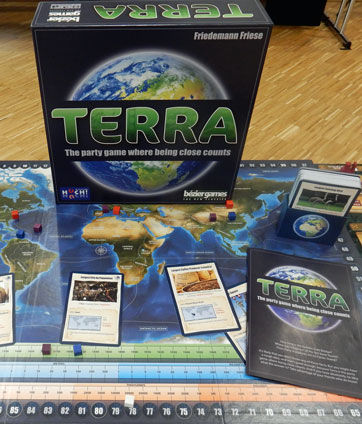
Terra on display (P)
The second game was Terra, a geography trivia game from Friedemann Friese. This is essentially a development of his Fauna game (where the questions were about animals) from 2008 and is being published in several languages by different companies. The game's saving grace is that players don't have to know the answer, they just need to be closest - and can be played using metric or imperial measurements. However, it's not my cup of tea and I let this one go by as well.
Much more to my taste are the two expansions. Suburbia: 5 Star (Ted's own design) adds tourism to the base game, giving players something else to collect (stars) and providing pieces for a fifth player. Castles of Mad King Ludwig: Secrets (also designed by Ted) adds all manner of interesting twists to this game. Surrounding your castle with moats can score lots of points, for example, but this limits where you can add rooms. Then there are the secret passages and the swans hidden in some rooms... I've added it to my copy of the game already.
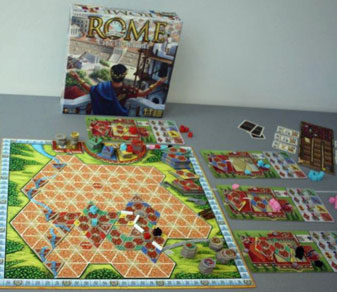
Sunglasses on: ROME: City of Marble on display (M)
In my final corner of Hall 1 there were plenty of new games with US publisher R&R Games, two of which caught my eye. The first was the English language edition of Mombasa, which I've already covered with the German publisher, eggertspiele. The second was Rome: City of Marble, designed by Brett Myers. In this case, the eye-catching bit was the dazzling graphic design of the game's board. I picked up a copy to try, but will be keeping the sunglasses to hand when I do so.
Into Hall 2
It's time to go through to Hall 2. This is dominated by the role-playing, wargames and comics elements of Spiel, which means less for me to report. However, my first find was Modiphius Entertainment. Amongst the role-playing stuff on their stand was a demo copy of Thunderbirds, their new co-operative game designed by Matt Leacock. Production copies have arrived since Spiel and I've played once so far. The game is, of course, based on the famous 1960s TV series of the same name and needs no introduction to any Briton of a certain age. As you'd expect, the players take on the roles of the members of International Rescue (specifically, the Tracy brothers and Lady Penelope) and must work together to thwart the various threats facing the world.
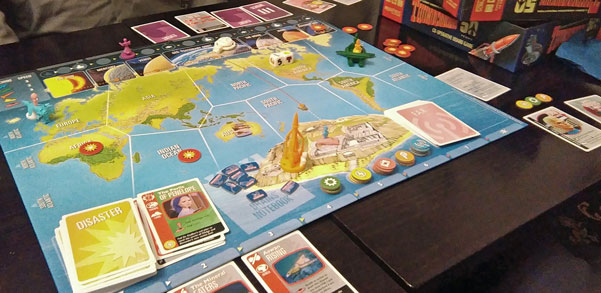
Playing Thunderbirds at Swiggers – with Lady P in Thunderbird 3! (P)
Each round a new emergency crops up somewhere and the players need to get the right equipment and team members to the site. At first it seems the team has plenty of time to deal with these, so they can plan how to tackle them. However, if too many of these line up along the bottom of the board, the players lose. And the bigger threat is master-spy The Hood, whose schemes form a track along the top of the board. These are harder to deal with than the usual emergencies and, if the players miss one, they lose.
All of this adds up to lots of time pressure on the players and they have to work hard to win the game. The tension throughout means that winning feels like a real achievement. And it's great fun - especially when familiar episodes crop up as the next emergency. Another great feature is the playing pieces: neat little models of each Thunderbird machine and FAB 1 (Lady P's pink Rolls Royce). Each team member is represented by a head-and-shoulders figure with a peg base that can be slotted into the holes in the machines - very neat.
I've only played Thunderbirds once so far, but enjoyed it hugely and am looking forward to playing it a lot more. I'm also looking forward to the expansions due out soon: models for all the Thunderbird 2 equipment (the Mole, Firefly et al), extra characters (Brains, Parker and Tin-Tin) and more. How can I not give this an immediate 10/10 on my highly subjective scale?
I don't often mention 999 Games but I have to report what the Dutch nutters have come up with this year: Mega Civilization. Yes, this is based on Francis Tresham's legendary Civilization (the greatest game in all space and time, may I point out). While the Mediterranean and Middle East remain at the heart of the geography, other boards expand the playing area to Spain in the west and as far as India in the east. This allows up to eighteen players to take part. Eighteen players! The mind boggles. Particularly as a standard game with seven players needs a full day to play.
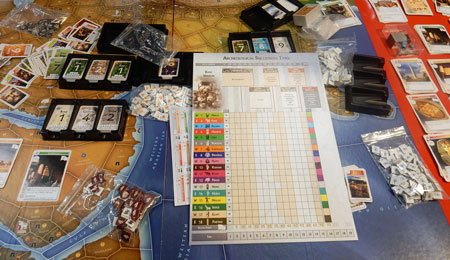
A taste of Mega Civilization on the Pegasus stand (P)
Discussing it with the guys on the Pegasus stand (Pegasus are distributing the game), they were keen to point out that the designers have streamlined gameplay even as they have adjusted details from the original (such as larger spaces for areas in Greece). In particular, there is now much that can be done simultaneously, especially when there is no conflict between players. They emphasised how much fun the trading part of the game is when you have eighteen players around the table all trying to get a deal. It becomes like a real-life trading pit as buy and sell offers are shouted across, players standing up and waving their cards as they make offers and counter-offers.
That's a lot of game. Like the original, the rules include scenarios for different numbers of players and offer plenty of variety for which boards are used. There are also scenarios that start at a later point in civilizations' development to give a shorter game. The production quality of the game is high and it comes in a wooden case, the whole weighing in at over 10 kilos. Not surprisingly, this is a limited edition and has a hefty price tag (€200, I believe). It really just needs one person in a group (county?) to own a copy and, much as I'd like a copy, I don't think that will be me.
PSC Games were showing the prototypes for the Tank expansion for The Great War. This was a Kickstarter project that was successfully funded at the end of October. Based on the prototype models, I'm really looking forward to seeing the finished article. According to the Kickstarter pages, it will contain four British tanks (two 'male', two 'female'), two German tanks and two German field guns (and crew). That last is interesting as, in the base game, field artillery is not represented on the board. The expansion comes, of course, with additional rules and plenty of scenarios to test the new equipment.
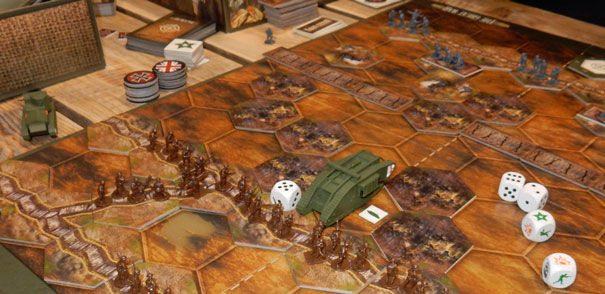
Tank! A British tank supports the infantry (with a Whippet off-board) (P)
According to the PSC guys, British Whippet tanks will be available, in blister packs, as a separate expansion next year and this will be followed by French Army pieces. All of which will provide lots of additional fun for fans of the base game, like me. My initial thoughts on The Great War are in my report from this year's UK Games Expo - see my website or TWJO issue 156.
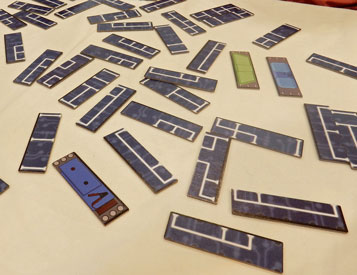
The "before" picture – robot bits (P)
Arctic Union is an umbrella for several Nordic games companies and had the usual interesting selection of new games on show. These included Playmore Games and their Race for the North Pole, which I saw at the UK Games Expo earlier this year (see TWJO 156). Copies of the game were available at Spiel and had sold out by the end of the show. However, the game I tried here was Tiny Robots, designed by Pekka Koukkula and published by Doorway Games. the game is played with cardboard strips that show a section of a robot in a particular colour on one side and blueprint-style wiring connections on the other. The aim is to construct robots, scoring points for the number of strips used, with a bonus if they're all in the same colour and a penalty for any unconnected wiring.
Naturally, the strips start the game mixed up and face down in the centre of the table. Each turn, you may turn over some strips to find out what the picture is on the other side. However, as this is public, the other players get the same information. Assuming that they - and you - can remember which bits were where, you may then take one strip and add it, still face down, to the robot you're constructing. At this stage, it's all about joining up the connections - though you could throw caution to the winds and just grab bits, accepting the penalties.
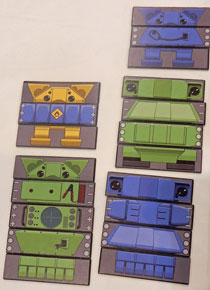
My cute Tiny Robots (P)
When you feel your robot is big enough, you check how many loose ends are left in the wiring and turn over all the strips to reveal your finished creation. You then work out what you score for that robot and start again. Players can pass if they think there's nothing worth picking up and the game ends either when everybody passes or all the tiles have gone. I played this with Mike Dommett and Pete Card at the Arctic Union stand and, while it was quite fun, I can't say it was a big hit with me. Tiny Robots gets 6/10 on my highly subjective scale.
I wasn't expecting North and South Games to have anything new at Spiel, having seen the guys at the UK Games Expo just a few months ago. They surprised me with the prototype of Bun Fight, a game of food-fighting teddy bears (!) from main man Dave Cousins. It's a card game with cards representing food items available at several 'tables'. Players move between tables, grab something messy and hurl it at another player - doing extra damage at close range. Last teddy bear standing wins. The key move is stunning other players so that they're sitting ducks. It reminds me of Kersplatt!, Ed Carter's entertaining food fight card game from twenty years ago, and is just as much fun. It gets 8/10 on my highly subjective scale.
As I was pushed for time this year, I didn't get the chance to say my customary hello to Rick Loomis, doyen of postal games and main man at Flying Buffalo, Inc, publisher of Nuclear War amongst others. So let me take the opportunity now: "hello, Rick". In recent years Flying Buffalo has resurrected the Ace of Aces games, which I certainly appreciate.
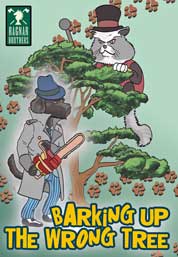 Following on from the heavyweight DRCongo, the Ragnar Brothers' latest Kickstarter project is a much lighter card game, Barking up the Wrong Tree. This is an entertaining card game of dogs and trees. Players use their dog
cards (and the occasional cat) to 'claim' trees. Sets of trees are what score points. So far, so simple, although the competition for the trees complicates things.
Following on from the heavyweight DRCongo, the Ragnar Brothers' latest Kickstarter project is a much lighter card game, Barking up the Wrong Tree. This is an entertaining card game of dogs and trees. Players use their dog
cards (and the occasional cat) to 'claim' trees. Sets of trees are what score points. So far, so simple, although the competition for the trees complicates things.
The first round is straightforward, as any tree is useful and players only have a few cards. However, after this players have specific targets and more cards. This is where the game takes off as players manoeuvre to get what they want without giving too much away to their opponents. There's plenty of bluff and counter-bluff, making this game much more subtle than it appears to be at first. It gets an initial 7/10 on my highly subjective scale.
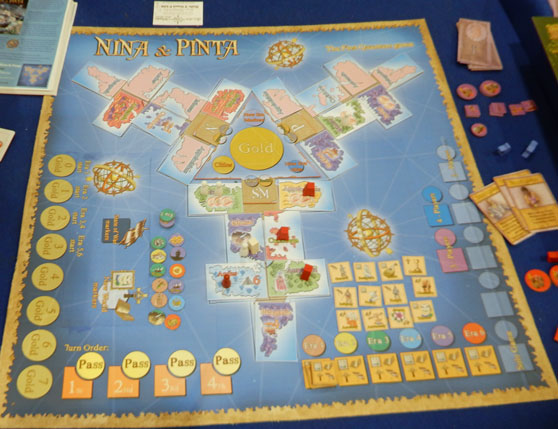
The Niña and Pinta prototype (P)
The Ragnars also had the prototype of their next game, which has now been launched on Kickstarter. Niña and Pinta is billed as "the first quantum game" and features all three ships on Columbus's expedition. The idea is that the ships end up in different multiverse dimensions, finding three different Americas. As different Empires, players thus explore and develop parallel versions of the continents with both complementary and contradictory elements. It sounds fascinating and I look forward to the completed game.
I was quite taken with Baksha Games' What's he Building in There? last year and this year's game, Time Jockeys, was successfully launched on Kickstarter. See the website for more information. Designer Sean Garrity was showing off the prototype of their next game, A Little Drop of Poison. This is a simple card game of feuding tribes of rats and weasels. Each round, players are either a rat or a weasel and the King of one tribe is the target.
Players are dealt two cards at the start of each turn, adding them to any cards they've held over. The cards show 1-3 drops of poison in a particular colour. Players then choose as many cards as they like (but at least one) and put them, face-down, against one of the other players or the King. Once everybody's chosen, the cards are revealed. If there's enough poison in at least one colour, the target snuffs it. Everybody who played any of the cards that contributed to the target's demise scores the appropriate points: 1 for another player, 2 for their own tribe's King and three for the opposing tribe's King.
The round ends when the King dies or if there's only one player left. If anybody's achieved 10 points or more, the game is over and the player with the most points wins. If not, it's time for another round.
On first acquaintance, there doesn't seem to be a lot to this game though it's mildly entertaining. Clearly, you don't want to make it easy for other players to kill the King - or other players. So players play one-drop cards until they have enough cards of the same colour in hand to make a strike. However, a three-drop card is enough to take out an opponent in one go, so those who draw one of these will do so. Expect old grudges to surface as players decide who to take out!
Essentially, this appears to be a game of pure luck with the amusement provided by picking on other players. I could see it going down well with children, except that their parents probably won't appreciate the theme. It gets 3/10 on my highly subjective scale.
The Galeria and Hall 7
Having reached the far side of Hall 2, the next step is into the Galeria, a long, narrow hall used as a children's playground during Spiel. It's all bouncy castles, trampolines and flying things - great fun. It also connects Hall 2 with the back of Hall 3 and, on the other side, Halls 4 and 7. This year Hall 4 was used to set a new world record for the biggest game of (Settlers of) Catan - over a thousand players! This left Hall 7 to continue the main business of Spiel - though only part of it was in use and I didn't find much to report on here.
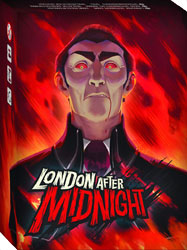 The Spanish team at Gen X Games were busy every time I went past, so that didn't find out about their games either. The two I could see on show were Dark Matter - a card game with writing on the back of the cards, Hanabi style - and London After Midnight, a game of fighting monsters from horror fiction (such as Frankenstein's creation,
Dracula et al)
on the streets of London.
The Spanish team at Gen X Games were busy every time I went past, so that didn't find out about their games either. The two I could see on show were Dark Matter - a card game with writing on the back of the cards, Hanabi style - and London After Midnight, a game of fighting monsters from horror fiction (such as Frankenstein's creation,
Dracula et al)
on the streets of London.
Eagle Games (www.eaglegames.net) was also tucked away in hall 7. However, the company has combined its two brands and now hyphenates the company name as Eagle-Gryphon Games (presumable EGG for short). They had a slew of games on display, including the English language edition of the new Through the Ages.
There were lots of brightly coloured boxes on the Mayday Games stand. I particularly noted the 3-in-1 collector set of Get Bit, Hold Your Breath and Walk The Plank. On top of this, there was Dead Man's Draw (designed by Allison Litchfield), a simple push-your-luck game of drawing cards and collecting pirate treasure. The more cards you draw, the more treasure you get, but the more likely you are to go bust and lose what you've collected so far. A neat touch is being able to combine cards' powers for even greater rewards.
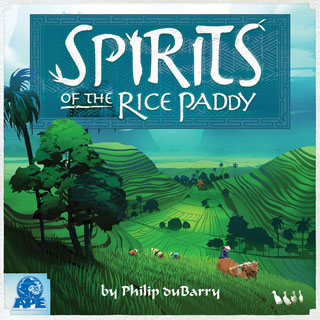 APE Games were rather hidden away but had copies of their successful Kickstarter game, Spirits of the Rice Paddy. This was designed by Philip duBarry, whose Kingdom of Solomon I really enjoyed (see my review in TWJO 128). The
setting of this game is Bali, where traditional rice farmers succeed through a combination of engineering - sophisticated irrigation systems
- and religion - entreating the spirits to bless the crops.
APE Games were rather hidden away but had copies of their successful Kickstarter game, Spirits of the Rice Paddy. This was designed by Philip duBarry, whose Kingdom of Solomon I really enjoyed (see my review in TWJO 128). The
setting of this game is Bali, where traditional rice farmers succeed through a combination of engineering - sophisticated irrigation systems
- and religion - entreating the spirits to bless the crops.
As rice farmers, players must carefully construct and tend their paddies. They must clear the ground, construct walls, fertilise their crop and deal with pests. Above all, they must use their water supply effectively. It's a tricky business and a little help from the spirits doesn't come amiss. Hence, players need a combination of planning, organisation and luck to be the most successful rice farmer. The game looks intriguing and is helped by atmospheric artwork. It's another one I look forward to playing.
In conclusion
Many of the photos in this report were taken at the "new games display" for the press. While I was doing so, I bumped into Richard Ham, aka Rahdo. You can see his video run-through of the display on YouTube. Keep an eye open for the portly fellow in the pink shirt who pops up in the background during the last couple of minutes. Yes, it's yours truly!
I must finish by thanking Dominique Metzler and the whole team at Friedhelm Merz Verlag for their hard work in putting on another terrific show. Spiel '16 is scheduled for 13th-16th October 2016 at the Messe Essen - see you there.
And finally…
After the adventure of getting to Essen, the excitement wasn't quite over for Mike and me. You will recall that we ended up with a French hire car to replace Mike's broken down company vehicle. However, we were instructed not to take it to the UK. We had to return it to a depot in Calais and pick up a British-registered, right-hand drive car. We did not expect that a 9 pm rendezvous on a Sunday night would go according to plan, but it did. It took a while to complete the paperwork and transfer the luggage - augmented by the boxes we'd picked up at Spiel - but the return journey, in car number three, went smoothly. Phew!
© Copyright Paul Evans 2015. All trademarks acknowledged.
Photos were taken by Mike Dommett (labelled 'M') or Pevans (P) and Pevans played with Photoshop.
An edited version of this report was published in To Win Just Once issues 159 and 160 (November and December 2015).

